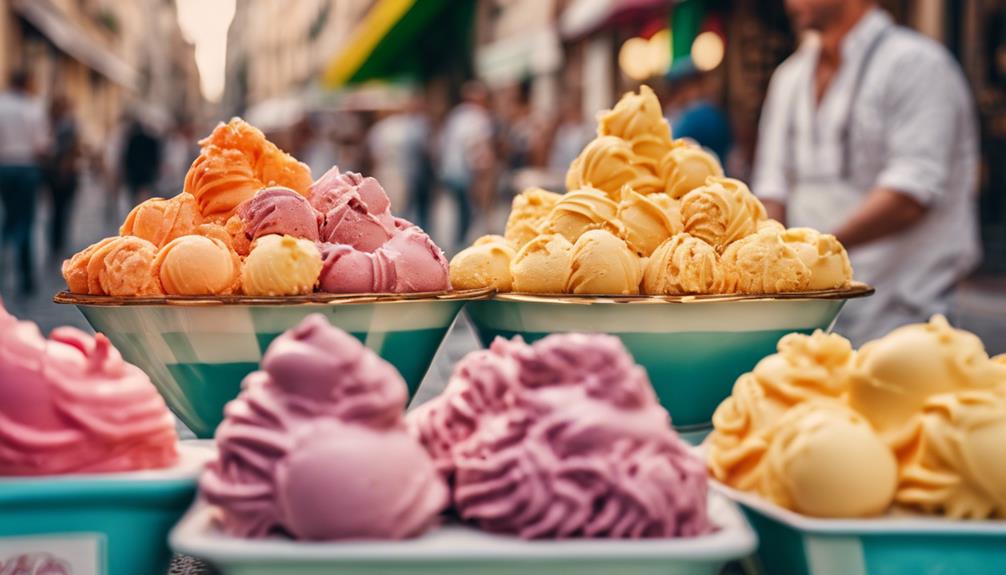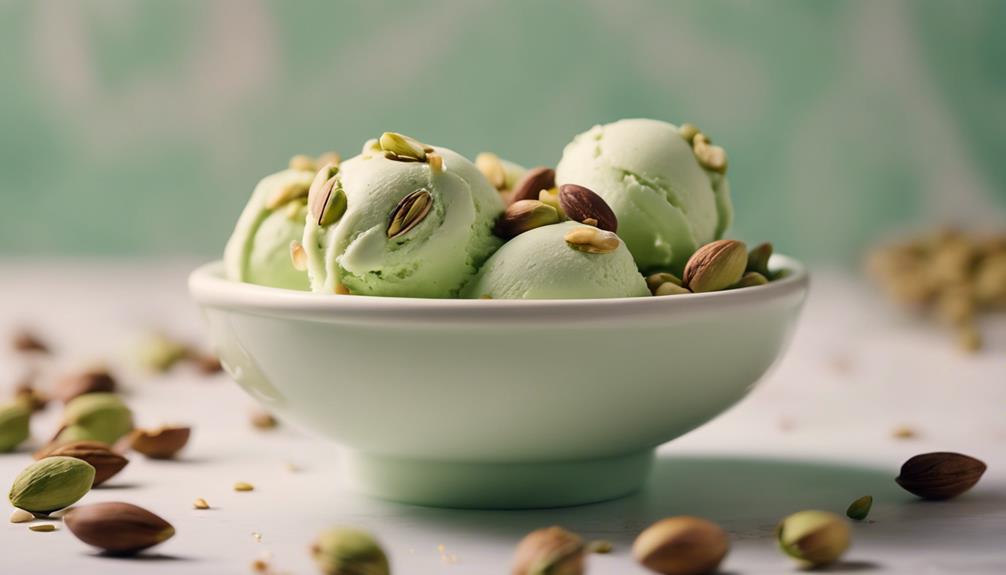For the top gelato in Rome, you must visit Fatamorgana, where innovative flavors like black sesame and basil are waiting for you. Neve di Latte stands out with Sicilian ricotta and seasonal chestnut cream in a stylish atmosphere. If you’re feeling daring, check out Otaleg for distinctive combinations like cacio e pepe. Gelateria dei Gracchi is ideal for organic choices, showcasing sweet potato and pear gelato. And of course, don’t miss Giolitti, a legendary spot with traditional flavors. Each gelateria has something special to offer, so be sure to try them all. Stay around and discover even more hidden gems and unique flavor profiles throughout the city!
Key Takeaways
- Fatamorgana offers inventive flavors like black sesame and basil, using all-natural ingredients for a unique gelato experience.
- Neve di Latte features seasonal delights such as Sicilian ricotta and chestnut cream in a modern atmosphere.
- Gelateria del Teatro showcases rich flavors with fresh, seasonal ingredients, including olive oil gelato and fresh apricot sorbet.
- Come Il Latte specializes in unconventional combinations like parmesan and sweet corn, with vegan and low-carb options available.
Gelato Tasting Experience

When you start on a gelato tasting adventure in Rome, you'll quickly discover that personal preferences play a significant role in shaping your favorite flavors. Each gelateria offers unique options, often made with all-natural ingredients that enhance the authenticity of the tasting experience.
To truly appreciate each flavor, try to sample gelato under consistent conditions. This means visiting one gelateria at a time and opting for smaller sizes, especially during the hot summer days, to prevent rapid melting and guarantee you savor every bite.
As you explore, don't hesitate to ask locals for recommendations. They can lead you to hidden gems and lesser-known gelaterias that may surprise you with their exceptional offerings.
You might find innovative flavors at well-known spots like Fatamorgana and Günther, which push the boundaries of traditional gelato. Ultimately, your tasting experience will be a delightful journey of self-discovery, as you uncover which combinations of flavors resonate with your palate.
Top Gelaterias in Rome

When you're in Rome, the variety of gelaterias will impress you with their unique flavor offerings and traditional experiences.
You'll find spots like Fatamorgana and Neve di Latte catering to adventurous tastes and health-conscious choices.
Whether you crave innovative combinations or classic favorites, there's a perfect gelato waiting for you.
Unique Flavor Offerings
Rome's gelaterias boast some of the most inventive flavor offerings, making every scoop a delightful adventure for your taste buds.
At Fatamorgana, you'll discover innovative flavor combinations like black sesame, basil, and horseradish, all crafted from all-natural ingredients without additives.
If you're in the mood for something truly unique, head to Otaleg where cacio e pepe and fava beans with Pecorino await, alongside invigorating seasonal fruit sorbets like passion fruit and strawberry.
For those who appreciate artisanal gelato, Gelateria dei Gracchi stands out with its use of organic milk and seasonal fruits, featuring distinctive flavors such as sweet potato and pear.
Meanwhile, Come Il Latte offers unconventional options like parmesan and sweet corn, made from milk sourced from grass-fed cows, plus sugar-free and vegan-friendly choices.
Don't miss Gelateria del Teatro, where rich, authentic flavors shine through seasonal ingredients, serving creative options like olive oil cones and fruit-based sorbets.
With these unique flavor offerings, exploring Rome's gelaterias is sure to be a memorable experience that goes beyond the ordinary.
Traditional Gelateria Experiences
Exploring unique flavors is just the beginning; traditional gelaterias in Rome offer unforgettable experiences steeped in history and authenticity.
You can't miss Giolitti, established in 1900, famous for its classic favorites like pistachio and zabaione. The elegant interior adds to the charm of this must-visit gelato shop.
Another gem is Gelateria Fassi, operating since 1880, where you can savor their unique sanpietrini dessert shaped like cobblestones. They're known for seasonal flavors like zabaione and persimmon, making each visit a delightful surprise.
In Trastevere, Fiordiluna stands out with its creamy mascarpone gelato and innovative yogurt flavor, all crafted from high-quality local ingredients.
At Neve di Latte, you'll find standout flavors like Sicilian ricotta and seasonal chestnut cream, with a commitment to organic and biodynamic practices.
Lastly, Fatamorgana delights with all-natural ingredients and rotating seasonal options that cater to various dietary restrictions.
Each of these gelaterias not only serves some of the best gelato in Rome but also immerses you in traditional gelateria experiences that celebrate Italy's rich dessert culture.
Health-Conscious Options Available
Looking for health-conscious gelato options in Rome? You'll find plenty of top gelaterias that cater to your dietary needs without sacrificing flavor.
At Brivido Gelateria, you can indulge in all-natural ingredients with vegan and sugar-free choices, making it a favorite for those who prioritize health.
Gelateria del Teatro offers a diverse range of dairy, egg, and gluten-free options, ensuring everyone can enjoy their delicious gelato.
If you're after low-carb or vegan-friendly treats, Come il Latte has you covered with daily options made from milk sourced from grass-fed cows and local farm fruits.
For innovative flavor combinations, check out Fatamorgana, known for its emphasis on health benefits and natural ingredients, all while providing nut and gluten-free selections.
Tips for Enjoying Gelato

To fully savor your gelato experience, be ready to embrace the lively atmosphere of busy gelaterias and navigate their unique ordering processes. At popular gelato spots like Giolitti, you often need to pay before choosing your flavors, so keep this in mind.
During the hot summer months, opt for smaller gelato sizes. This way, you can prevent melting issues and enjoy your treat without a sticky mess. Always look for shops that prioritize natural ingredients; avoid brightly colored gelato, as it can indicate artificial additives.
When visiting gelaterias like Fatamorgana or Otaleg, be adventurous and try their unique flavors. These places frequently rotate their menu, showcasing seasonal ingredients and creative combinations that you won't want to miss.
For a cleaner experience, use hand sanitizers or wipes to handle your gelato, and don't forget to stay hydrated. Public water fountains are perfect for this while you enjoy your sweet treat.
Following these tips will enhance your journey to find the best gelato in Rome, ensuring it's a delicious and enjoyable experience!
Dietary Considerations

When you're in Rome, you'll find that many gelaterias cater to dietary needs, offering a variety of vegan, gluten-free, and dairy-free options to satisfy everyone.
For those seeking gluten-free gelato, spots like Grom are certified by the Italian Celiac Association, ensuring safe choices for individuals with celiac disease.
If you're looking for vegan options, gelaterias like Brivido Gelateria and Gelateria del Teatro focus on all-natural ingredients, steering clear of artificial additives.
Dairy-free selections are also plentiful, with places such as Gelateria Come il Latte and Fatamorgana providing sugar-free and low-carb choices daily. These options make it easier for you to indulge without worrying about dietary restrictions.
Don't forget to explore the seasonal offerings at Gelateria dei Gracchi, where you can find unique flavors like vegan pistachio and invigorating fruit sorbets, perfect for a hot day.
Many gelaterias, including Neve di Latte and Otaleg, prioritize high-quality organic and biodynamic ingredients, promoting health-conscious choices without sacrificing taste.
With so many options available, you're sure to find a gelato that fits your dietary preferences.
Unique Flavor Offerings

When you're exploring gelato in Rome, you'll want to seek out those unique flavor combinations that surprise your taste buds.
From the intriguing mix of walnuts and rose petals at Gelateria Fatamorgana to the savory cacio e pepe at Otaleg, there's no shortage of creativity.
Plus, seasonal ingredients add a fresh twist, making each visit an exciting adventure in flavor.
Creative Flavor Combinations
Creative flavor combinations in Rome's gelato scene invite you to experience bold and unexpected pairings that redefine traditional tastes. From savory to sweet, the gelato shops in this vibrant city push the boundaries of flavor with inventive offerings.
| Gelateria | Creative Flavor | Description |
|---|---|---|
| Otaleg | Cacio e Pepe | A creamy blend of cheese and pepper, a true Roman classic. |
| Fatamorgana | Thumbelina | A whimsical mix of walnuts and rose petals inspired by fairy tales. |
| Gelateria dei Gracchi | Sweet Potato and Pear | A unique combination emphasizing organic ingredients. |
| Come il Latte | Parmesan and Sweet Corn | A surprising but delightful savory-sweet twist. |
Whether you're exploring cacio e pepe at Otaleg or indulging in the enchanting Thumbelina at Fatamorgana, each scoop promises an unforgettable taste experience. These creative flavor combinations not only elevate gelato but also invite you to embrace a new perspective on dessert. So, don't hesitate to step out of your gelato comfort zone and savor the extraordinary.
Seasonal Ingredient Highlights
Exploring seasonal ingredients in Rome's gelaterias reveals a world of unique flavor offerings that celebrate the freshest tastes throughout the year.
You'll be delighted by the creative use of organic ingredients, resulting in seasonal flavors that you won't find anywhere else. Here are some must-try options:
- Fatamorgana: Immerse yourself in their Thumbelina gelato, blending walnuts and rose petals for a truly innovative experience.
- Gelateria del Teatro: Savor their fresh apricot and basil sorbet, perfect for those hot summer days.
- Gelateria dei Gracchi: Treat yourself to their sweet potato and pear flavor, crafted from organic ingredients that highlight seasonal freshness.
- Otaleg: Experience adventurous flavors like cacio e pepe and fava beans with Pecorino, where tradition meets modern creativity.
Don't miss out on Neve di Latte, which frequently updates its menu with unique seasonal flavors like chestnut cream in the fall.
Each gelateria showcases its dedication to quality and innovation, ensuring that your gelato experience in Rome is both memorable and delicious!
Gelato Experience and Ambiance

The gelato experience in Rome is as much about the ambiance as it is about the delicious flavors, with each gelateria offering its own unique atmosphere that enhances your enjoyment. You'll find that the setting can elevate the simple act of tasting gelato into a delightful occasion.
| Gelateria | Ambiance Description | Special Features |
|---|---|---|
| Come il Latte | Elegant interior by chef Nicoletta | Handmade wafers and chocolate drizzle |
| Neve di Latte | Modern and minimalist with comfy seating | Relaxed atmosphere for tastings |
| Fatamorgana | Minimalist setup focusing on gelato quality | All-natural ingredients and unique flavor pairings |
| Fiordiluna | Vibrant and cheerful ambiance | High-quality gelato from local producers |
| Gelateria della Palma | Lively 1980s aesthetic with glass counter | Immersion in the gelato-making process |
Whether you're indulging in high-quality gelato at Fiordiluna or savoring unique flavor pairings at Fatamorgana, the ambiance is integral to your overall experience. So, take a moment to soak it all in while enjoying your sweet treat!
Community Engagement

In Rome, gelaterias aren't just places to enjoy a sweet treat; they actively engage with the community by sourcing local ingredients and encouraging customer feedback. This connection fosters a sense of belonging and pride in local traditions.
Here are some ways gelato shops in Rome embrace community engagement:
- Sustainable Sourcing: Places like Grom prioritize local farmers, ensuring fresh ingredients while supporting the local economy.
- Historical Reflection: Fassi Gelateria, established in 1880, showcases authentic Roman gelato culture, attracting both locals and tourists for a true taste of history.
- Customer Participation: Gelateria dei Gracchi invites patrons to share their feedback and flavor suggestions, making you feel part of the creative process.
- Innovative Flavors: Fatamorgana often crafts unique flavors inspired by local traditions, encouraging you to return and experience seasonal delights.
These gelato shops not only serve delicious treats but also create vibrant communities through shared experiences and dialogue about the best flavors.
Seasonal Innovations and Awards

Seasonal innovations in Rome's gelaterias keep your taste buds thrilled, with shops like Gelateria del Teatro and Neve di Latte constantly revealing unique flavors that celebrate local ingredients and culinary traditions.
At Gelateria del Teatro, you might find a delightful olive oil gelato or a sugar-free cream that's perfect for summer. Neve di Latte often rolls out holiday-inspired specialties that attract both locals and visitors to come back for more.
FataMorgana shines with its creative and invigorating flavor combinations, earning accolades in numerous food publications. Their inventive approach keeps gelato lovers on their toes, enthusiastic to try the latest concoctions.
Meanwhile, Gelateria della Palma stands out with an impressive array of 150 flavors, showcasing unique seasonal offerings that cater to adventurous palates.
Don't forget Grom, where the commitment to all-natural ingredients guarantees that every scoop is fresh and flavorful. Their regularly changing menu highlights the best of seasonal produce, promising an exquisite gelato experience.
With these gelaterias leading the charge, Rome's gelato scene is a showcase of innovation and quality, making every visit a sweet adventure.
Frequently Asked Questions
What Is the Most Popular Gelato in Italy?
Imagine savoring the rich, creamy texture of stracciatella or the nutty goodness of pistachio. In Italy, these classic flavors reign supreme, showcasing the artistry of gelato-making and the country's dedication to quality ingredients.
What Is the Famous Gelato Near Trevi?
When you're near the Trevi Fountain, you've gotta try Gelateria La Romana for its creamy textures or Giolitti for classic flavors. Don't miss Gelateria della Palma's vast selection, perfect for adventurous taste buds!
How Do You Pick Good Gelato in Italy?
To pick good gelato in Italy, look for shops with limited flavors, natural colors, and covered containers. Prioritize artisanal production and local ingredients to guarantee you're enjoying fresh, high-quality gelato every time.
Is the Gelatist in Rome Good?
You'll find Gelatist in Rome's vibrant heart, and it's definitely good! With unique flavors and a cozy vibe, you can't help but enjoy the delicious, natural ingredients and friendly service while savoring each delightful scoop.
Is Baja Blast Gelato Available at Any of the Top Gelato Spots in Rome?
Yes, baja blast gelato flavor is available at Gelateria Fatamorgana, one of the top gelato spots in Rome. This unique flavor combines the refreshing taste of Baja Blast with the creamy texture of gelato, creating a delightful and unexpected treat for visitors to enjoy in the Eternal City.
Are the Best Gelato Spots in Rome Romantic Locations for Couples?
Rome’s best gelato spots offer a love and gelato romance pairing for couples. Indulge in delicious flavors at Giolitti or Gelateria del Teatro and take a romantic stroll around the city. Whether it’s the iconic Trevi Fountain or the charming streets of Trastevere, gelato can add a sweet touch to your time together.
Conclusion
So, as you begin your gelato adventure through Rome, prepare for a heavenly experience that'll make your taste buds sing and dance!
With every scoop, you'll uncover divine flavors that could rival the gods themselves.
Don't just settle for the ordinary; indulge in the extraordinary gelaterias that line the streets.
Whether it's a creamy stracciatella or an exotic pistachio, each bite promises to elevate your sweet treat game to celestial heights!
Enjoy every moment!
















